Board of Education snubs massive protests, continues pushing Mayor's agenda at December 16 meeting
In what could only be described as an all-out assault on the Chicago Board of Education's corporate agenda and the pretensions of its "Chief Executive Officer", Ron Huberman, swarms of people surrounded the microphone all morning during public presentations at the Board's monthly meeting on December 16, 2009.
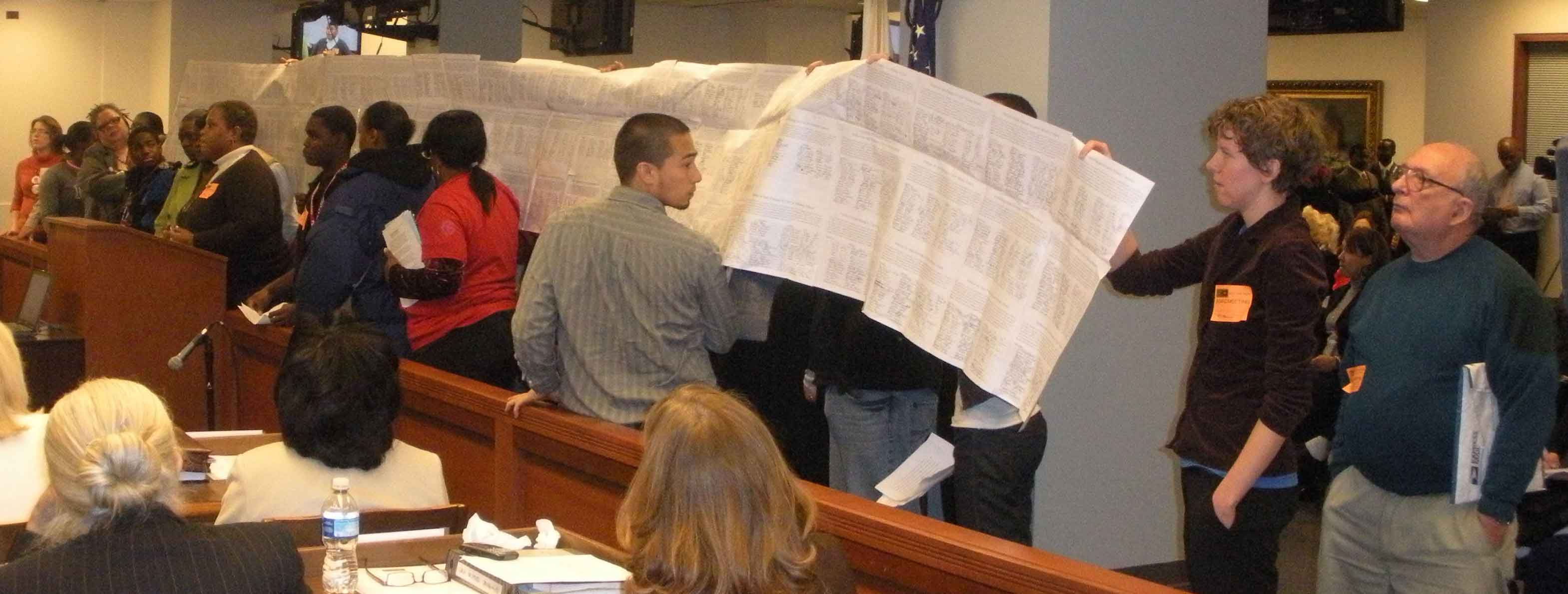 Community supporters of restoring Carver High School as a general high school unfurled a 15-foot long petition while community leaders spoke at the December 16, 2009, Chicago Board of Education meeting. Despite the protests, the Board voted to install a charter school which has been rejected by the community into the closed (2008) Carver Middle School building and to stall the community's demand that a general high school be located inside the massive Carver High School building, which currently holds only the small "Carver Military Academy High School." Substance photo by George N. Schmidt.The speakers and crowds demand a neighborhood public high school in the Altgeld Gardens; they protested the Renaissance Plan to close public schools; they objected to the new 'desegregation' plan in which selective enrollment schools will no longer use race to determine admission; and they tried to address a dozen other topics. The Board listened to only half the people who had come downtown to speak before cutting off public participation, rushing through their agenda, passing every proposal submitted to them by Ron Huberman, and leaving until next month.
Community supporters of restoring Carver High School as a general high school unfurled a 15-foot long petition while community leaders spoke at the December 16, 2009, Chicago Board of Education meeting. Despite the protests, the Board voted to install a charter school which has been rejected by the community into the closed (2008) Carver Middle School building and to stall the community's demand that a general high school be located inside the massive Carver High School building, which currently holds only the small "Carver Military Academy High School." Substance photo by George N. Schmidt.The speakers and crowds demand a neighborhood public high school in the Altgeld Gardens; they protested the Renaissance Plan to close public schools; they objected to the new 'desegregation' plan in which selective enrollment schools will no longer use race to determine admission; and they tried to address a dozen other topics. The Board listened to only half the people who had come downtown to speak before cutting off public participation, rushing through their agenda, passing every proposal submitted to them by Ron Huberman, and leaving until next month.
The December 16th meeting began by honoring the family of Mayor Daley's confidant and Board of Education President Michael Scott. Scott was found shot to death on November 16, 2009, last month in an apparent suicide, though many continue to harbor doubts. (After an extensive investigation, the Chicago Police Department affirmed an earlier decision by the Cook County Medical Examiner that Scott's death was a suicide).
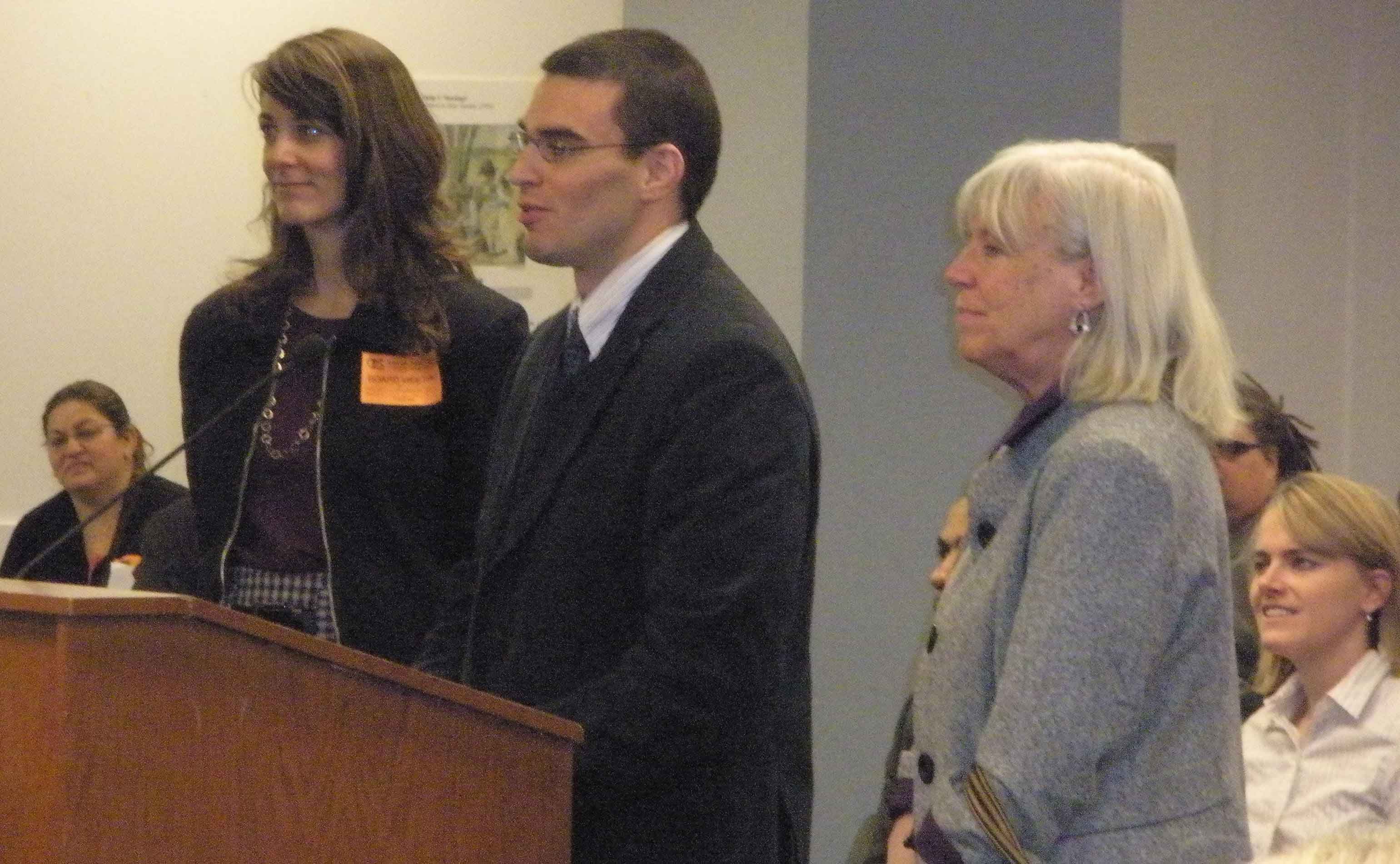 When Carl Schurz High School Economics teacher Kevin Rutter (above, center, with his sister and mother) received Board of Education plaudits for being named Illinois Teacher of the Year, he reminded the Board that his school, a general high school, rarely receives recognition for the fine job it does with the students it has. Later in the meeting, after Rutter and his family had departed, CEO Ron Huberman presented the Board with a "School Closing" policy that would allow Huberman to subject Schurz (along with every other general high school in Chicago, more than 40 schools) to so-called "turnaround" (such as was done in June 2009 to Fenger High School). If Huberman chooses to "turnaround" Schurz, Rutter would be fired, just as the teachers at Fenger were fired, and replaced by a novelty group of even younger teachers who had supposedly been trained in the latest sure-fire methods, as was done at Fenger. Substance photo by George N. Schmidt.The traditional monthly awards ceremony — the "Good News" part of each Board meeting — went to honor Kevin Rutter, an economics teacher and debate coach at Schurz High School who was named the Illinois Teacher of the Year, and Whitney Young Magnet High School, which was named a Blue Ribbon school by the U.S. Department of Education. Rutter told the Board it is important to note that Schurz “is a neighborhood school that doesn’t get enough recognition.”
When Carl Schurz High School Economics teacher Kevin Rutter (above, center, with his sister and mother) received Board of Education plaudits for being named Illinois Teacher of the Year, he reminded the Board that his school, a general high school, rarely receives recognition for the fine job it does with the students it has. Later in the meeting, after Rutter and his family had departed, CEO Ron Huberman presented the Board with a "School Closing" policy that would allow Huberman to subject Schurz (along with every other general high school in Chicago, more than 40 schools) to so-called "turnaround" (such as was done in June 2009 to Fenger High School). If Huberman chooses to "turnaround" Schurz, Rutter would be fired, just as the teachers at Fenger were fired, and replaced by a novelty group of even younger teachers who had supposedly been trained in the latest sure-fire methods, as was done at Fenger. Substance photo by George N. Schmidt.The traditional monthly awards ceremony — the "Good News" part of each Board meeting — went to honor Kevin Rutter, an economics teacher and debate coach at Schurz High School who was named the Illinois Teacher of the Year, and Whitney Young Magnet High School, which was named a Blue Ribbon school by the U.S. Department of Education. Rutter told the Board it is important to note that Schurz “is a neighborhood school that doesn’t get enough recognition.”
Then Whitney Young principal Joyce Kenner accepted the Board's praise for Whitney Young's being named one of the top public schools in the USA. Dr. Kenner made a major point in who she brought with her: she was accompanied by teachers, administrators, students, and LSC members from the school.
In her brief remarks to the Board, Dr. Kenner corrected the Board, which had stated that Whitney Young was the first Chicago Public School to receive the honor, noting that Jones High School and Payton High School, two other selective enrollment academic magnet high schools, had previously received the honor.
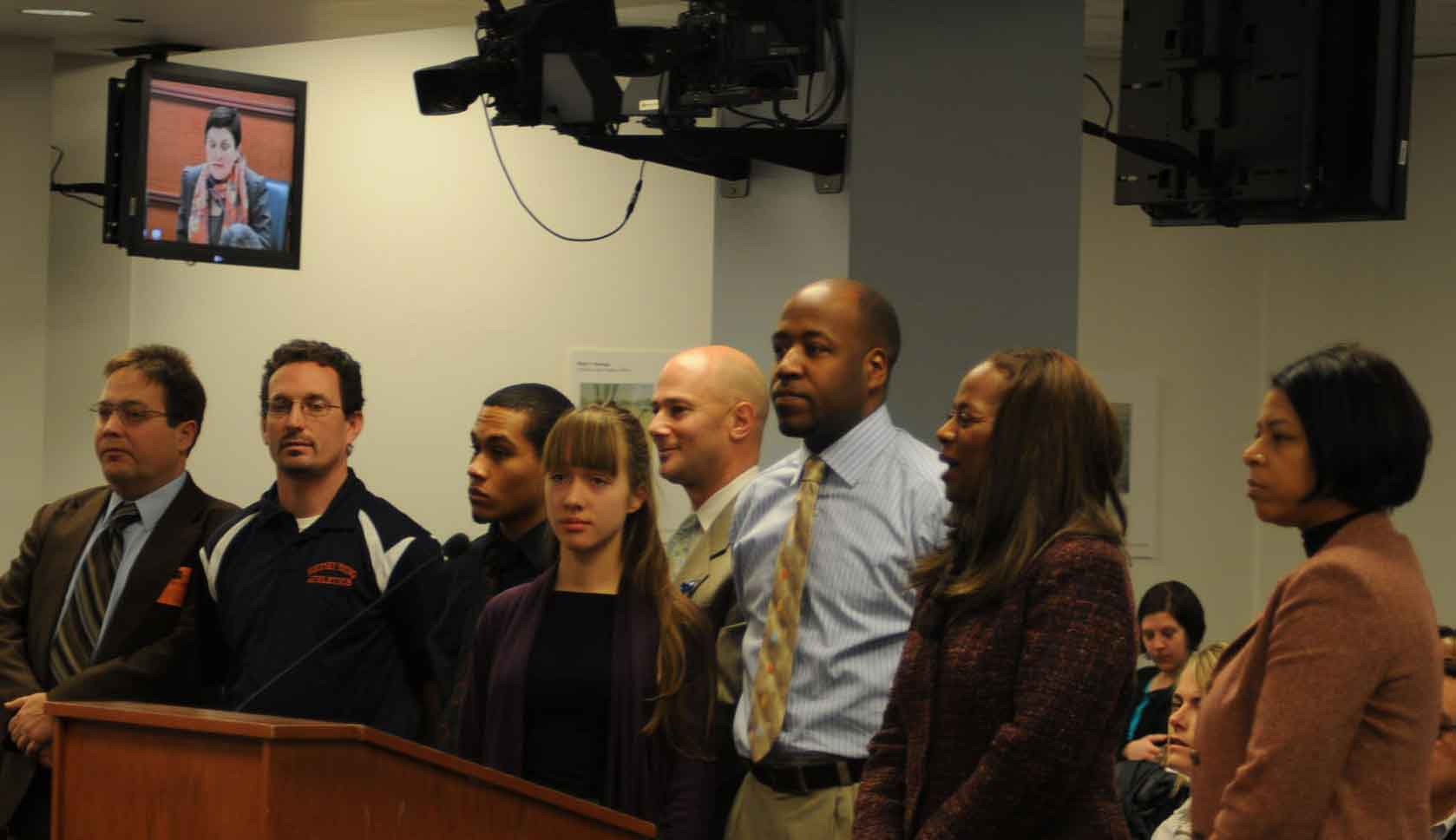 Whitney Young Magnet High School principal Dr. Joyce Kenner (above, second from right) made the point to the Board that her school's success was partly based on the kind of teamwork she displayed before them: teachers, students, administrators and parents. Kenner was also moved to correct the Board's claim that Whitney Young was the first school in Chicago to receive the recognition, noting that Jones and Payton high schools had been honored in the same way in years past. One of the ironies of the day, noted by teachers and principals present, was that Ron Huberman's new policy for selective enrollment high schools takes away the remaining discretion for selecting Young's students from Dr. Kenner and her fellow principals at the city's nine academic magnet (college prep) high schools.Dr. Kenner pointed out that Whitney Young's students were often not only scholars, but athletes, introducing the state's cross country champion to the Board. The President of the Whitney Young Local School Council also spoke about the teamwork that helped make the school a success. Under many of the policies of the Chicago Board of Education since the year 2001 (when Arne Duncan became CEO), local school counsels have been destroyed. During Duncan's years as CEO, he made it a point of snubbing Whitney Young during national media events, instead bringing national leaders and the media to the Noble Street Charter High School, a few miles away.
Whitney Young Magnet High School principal Dr. Joyce Kenner (above, second from right) made the point to the Board that her school's success was partly based on the kind of teamwork she displayed before them: teachers, students, administrators and parents. Kenner was also moved to correct the Board's claim that Whitney Young was the first school in Chicago to receive the recognition, noting that Jones and Payton high schools had been honored in the same way in years past. One of the ironies of the day, noted by teachers and principals present, was that Ron Huberman's new policy for selective enrollment high schools takes away the remaining discretion for selecting Young's students from Dr. Kenner and her fellow principals at the city's nine academic magnet (college prep) high schools.Dr. Kenner pointed out that Whitney Young's students were often not only scholars, but athletes, introducing the state's cross country champion to the Board. The President of the Whitney Young Local School Council also spoke about the teamwork that helped make the school a success. Under many of the policies of the Chicago Board of Education since the year 2001 (when Arne Duncan became CEO), local school counsels have been destroyed. During Duncan's years as CEO, he made it a point of snubbing Whitney Young during national media events, instead bringing national leaders and the media to the Noble Street Charter High School, a few miles away.
The temporary early morning calm quickly gave way to speaker after speaker in the opening round demanding that the Altgeld Gardens community get a public neighborhood high school. After Carver High School was closed and opened as a selective military school (the process was complete by 2006, when the last Carver general high school students graduated), students in the neighborhood — the massive Altgeld Gardens public housing project — have been forced to travel five miles away to the Fenger High School.
The 2006 closing of Carver as a general high school, coupled with the 2009 "turnaround" at Fenger High School (firing virtually all the veteran staff) resulted in the tragic fatal beating of Fenger junior Derion Albert on September 24, 2009. Fenger was a “turnaround school,” a controversial experiment in which the entire staff of the school is fired and replaced. As the speakers outlined the problems with Chicago's turnaround in December 2009, the U.S. Department of Education, under Arne Duncan, was ignoring the tragic lessons of Chicago and preparing to impose "turnaround" on 5,000 public schools across the USA.
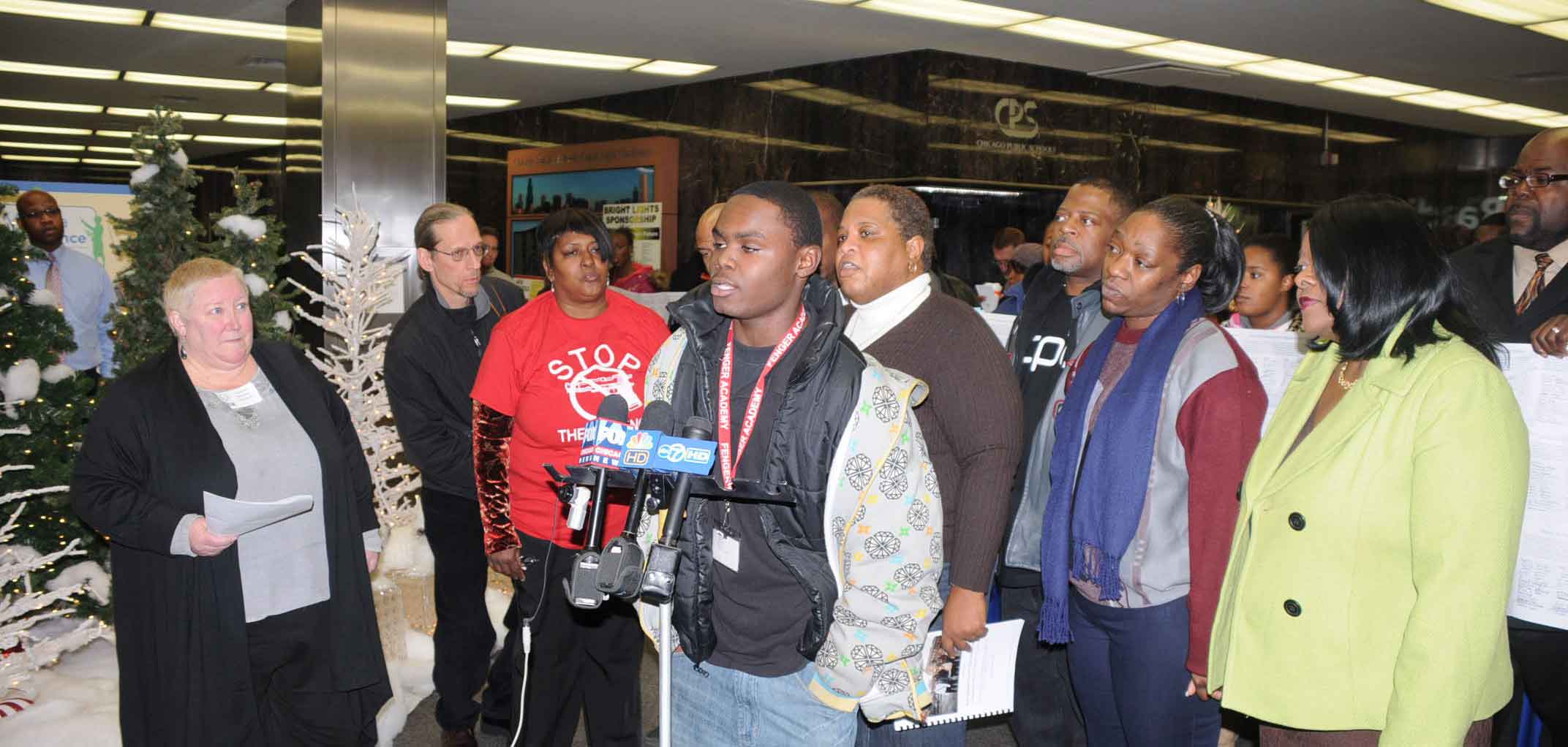 Fenger High School Junior Deontae Jones (above, at microphone) spoke at a press conference organized by GEM (Grassroots Education Movement) in the Board's lobby prior to the Board meeting. Jones, who lives in the Altgeld Gardens housing project, told the reporters that since Fenger went through "turnaround" this school year, he has had to be wary of violence just about every school day. He said that he was suspended for fighting, something that had never happened to him before the school slipped into chaos this school year. Substance photo by George N. Schmidt. Student Deontea Jones, who lives in Altgeld Gardens, complained that Fenger was too dangerous and told the Board (and an earlier press conference) that he had to be ready to fight every day this year at Fenger. Parent Marguerite Jacobs said the Chicago International Charter School — which the Board later voted on to place a new 6-12 CICS charter school in the Carver Middle School — is not the answer. Charters have an application process that can weed out “undesirable” students.
Fenger High School Junior Deontae Jones (above, at microphone) spoke at a press conference organized by GEM (Grassroots Education Movement) in the Board's lobby prior to the Board meeting. Jones, who lives in the Altgeld Gardens housing project, told the reporters that since Fenger went through "turnaround" this school year, he has had to be wary of violence just about every school day. He said that he was suspended for fighting, something that had never happened to him before the school slipped into chaos this school year. Substance photo by George N. Schmidt. Student Deontea Jones, who lives in Altgeld Gardens, complained that Fenger was too dangerous and told the Board (and an earlier press conference) that he had to be ready to fight every day this year at Fenger. Parent Marguerite Jacobs said the Chicago International Charter School — which the Board later voted on to place a new 6-12 CICS charter school in the Carver Middle School — is not the answer. Charters have an application process that can weed out “undesirable” students.
“The community doesn’t want a charter school,” said Cheryl Johnson, who helped work on the proposal for a new environmental school. “We want a public school.”
The message for a neighborhood school then unfolded literally before the Board’s eyes as students and other concerned community members held up a long list of over 1300 signed petitions by residents who agree with the proposal for a public school. One speaker noted that the Carver Miliatry Academy High School is only 26% utilized (the Board will close schools that are just under 40 percent utilized) and has space to fit at least 1,500 students.
Michael Brunson, a displaced teacher and member of CORE, said he taught in the Altgeld Gardens area for years and that the recent tragedy at Fenger told them they needed a neighborhood school. “We need a school with a functioning LSC and experienced teachers to avoid the type of tragedy that took place,” Brunson told the Board.
The Board responded that their TAC ("Transition Advisory Council) committee had invited the community and it decided the Chicago International Charter School would be the best fit, while Chief Administrative Officer Robert Runcie said they have helped facilitate over 150 transfers for Fenger students who wanted to leave the school and that other security measures are now in place.
Brunson noted earlier that the Board’s TAC’s force represented a lot of real estate interests, and told the Board that while the TAC may have served some purpose, “we’re still burning.”
“Will you read the proposal and schedule another meeting,” said UIC professor Rico Gutstein, “or do you want the blood of another child on your hands?"
Amid shouts of "What will the Board do?" Board vice president and moderator Clare Munana said they would meet with everyone in 30 days. (Minana has been chairing the Board meetings since Michael Scott's death on November 16. Mayor Daley has the power to fill the vacancy on the Board and appoint a President at any time he chooses).
The next wave of attacks focused on the corporate Renaissance Plan to close and privatize neighborhood public schools. A series of speakers (including this reporter) demanded to know when this plan will end and who on the Board will take responsibility for the increase in school violence and chaos that has resulted from it. Although the plan has been called "Renaissance 2010", it has been clear for two years that the Chicago Board of Education has directed its Office of New Schools to continue creating "New Schools" (mostly charter schools) beyond 2010.
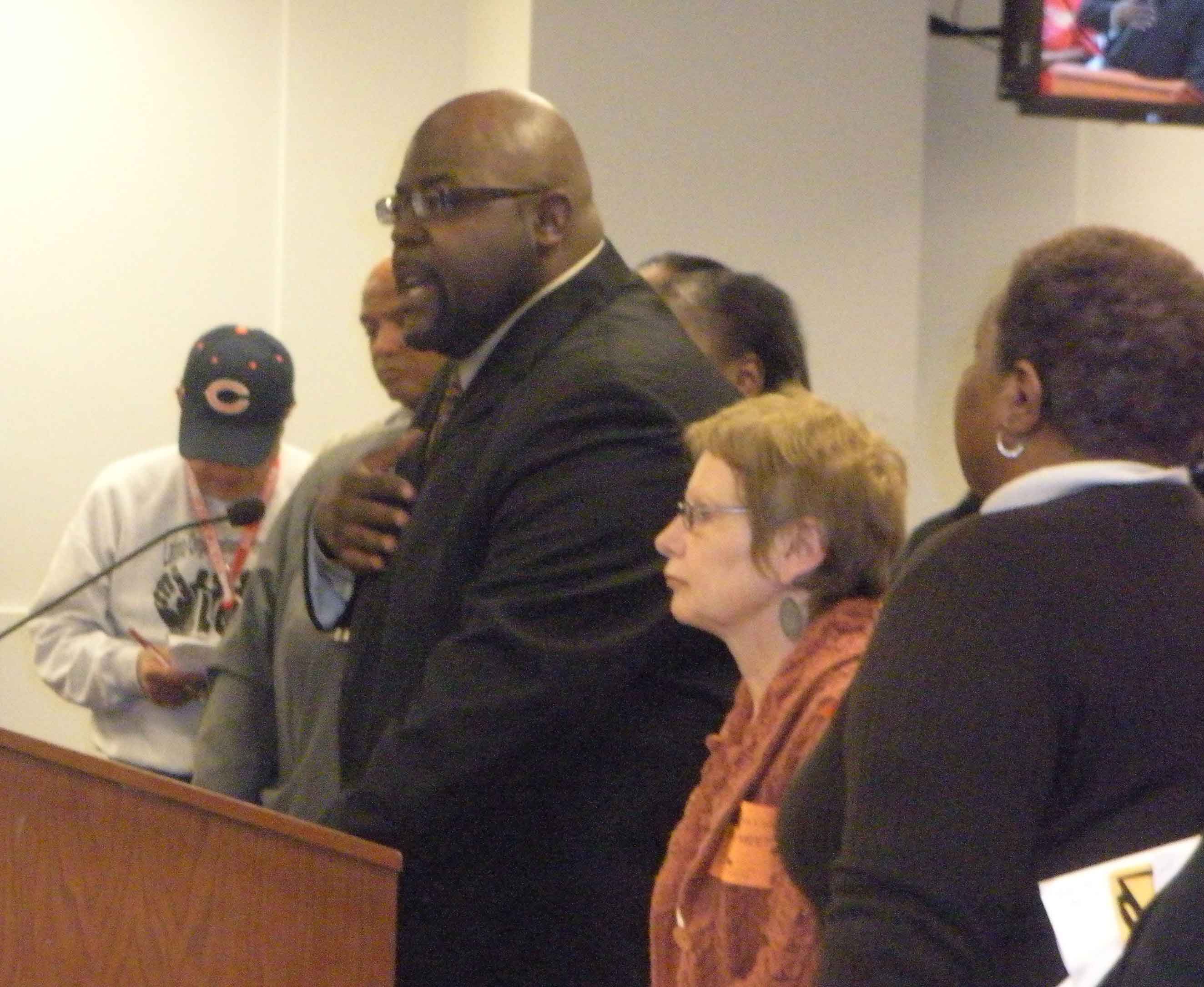 Jitu Brown (above, hand on chest) of the Kenwood Oakland Community Organization (KOCO) has been organizing against the closings since 2003. Brown was part of the group that did the study "Students as Collateral Damage" of the impact of the closings on the Mid-South region, where the first wave took place between 2002 and 2006. The lead researcher for the study, University of Illinois Professor Pauline Lipman (to Brown's left in the photo above) also testified at the December 16, 2009 Chicago Board of Education meeting. Substance photo by George N. Schmidt. Jitu Brown, from the Kenwood Oakwood Community Organization (KOCO), noted that after a number of schools were closed in the early years of "Renaissance 2010" in the so-called "Mid South" area, violence skyrocketed at the feeder schools. One receiving school — Doolittle East Elementary — had an increase of more than 300 students but did not receive any increase in security, Brown said.
Jitu Brown (above, hand on chest) of the Kenwood Oakland Community Organization (KOCO) has been organizing against the closings since 2003. Brown was part of the group that did the study "Students as Collateral Damage" of the impact of the closings on the Mid-South region, where the first wave took place between 2002 and 2006. The lead researcher for the study, University of Illinois Professor Pauline Lipman (to Brown's left in the photo above) also testified at the December 16, 2009 Chicago Board of Education meeting. Substance photo by George N. Schmidt. Jitu Brown, from the Kenwood Oakwood Community Organization (KOCO), noted that after a number of schools were closed in the early years of "Renaissance 2010" in the so-called "Mid South" area, violence skyrocketed at the feeder schools. One receiving school — Doolittle East Elementary — had an increase of more than 300 students but did not receive any increase in security, Brown said.
“Who’s held accountable for this,” Brown thundered. “We’ve had enough missteps to stop these school closings!” Brown noted that four years ago, he worked with University of Illinois Professor Pauline Lipman to produce a study ("Students as Collateral Damage") that showed the impact of the school closings in the Mid-South area on students. The Lipman study pre-dated the more recent University of Chicago study that raised criticisms of the way in which CPS has handled students during the school closing processes since 2002. The report "Students as Collateral Damage" was released in January 2007 and ignored by Arne Duncan and the members of the Chicago Board of Education. It is still available at the "old" Substance Web site (www.substance news.com) and can be accessed as it was published and reported in Substance [go to http://www. substancenews. com/content/view/431/88/].
UIC Professor Pauline Lipman continued the assault.
“It seems the agenda of the Board is to close minority schools and transfer them across the street with no better results for real estate interests,” she said. “In Chicago it is not an education plan, it’s a corporate plan. Who will take responsibility for this?”
Julie Woestehoff from PURE said it was time for each Board member to be held accountable — not just students and teachers — and, guess what, they all failed. She also asked that they refund all the money allocated to their expense accounts over the years. Woestehoff then read the amounts of money each of the Board members should refund to the taxpayers.
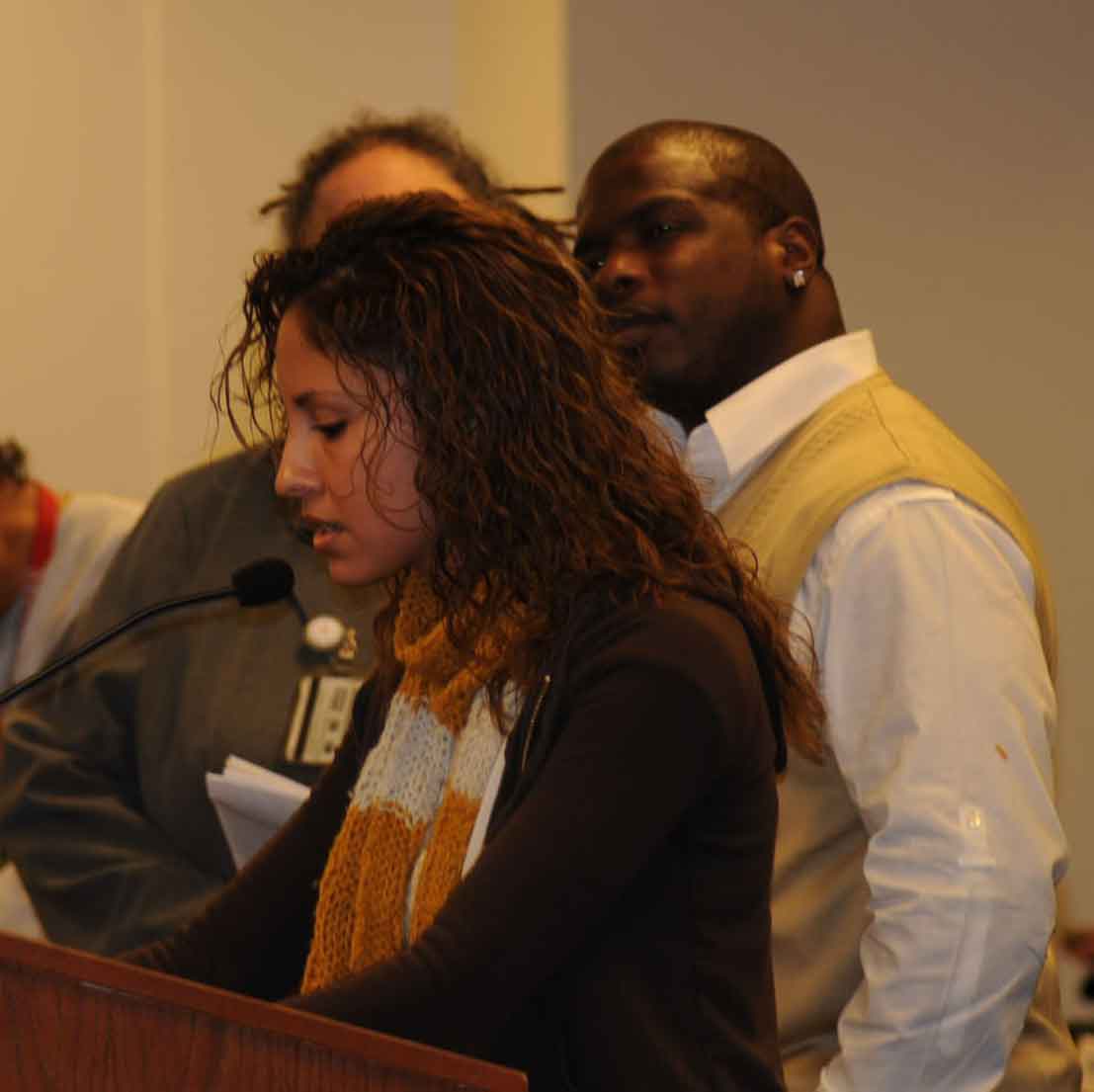 University of Illinois at Chicago student Alida Brambila was one of several people who spoke on behalf of the Altgeld Gardens proposal from Teachers for Social Justice. Substance photo by George N. Schmidt.One student from the University of Illinois at Chicago who spoke in favor of the Altgeld Gardens proposal, Alida Brambila, told the Board that it was time it stopped taking away from Black and Brown students.
University of Illinois at Chicago student Alida Brambila was one of several people who spoke on behalf of the Altgeld Gardens proposal from Teachers for Social Justice. Substance photo by George N. Schmidt.One student from the University of Illinois at Chicago who spoke in favor of the Altgeld Gardens proposal, Alida Brambila, told the Board that it was time it stopped taking away from Black and Brown students.
Another displaced teacher spoke after Brambila. “I’m a teacher in Englewood and we’re constantly worried about our school being shut down,” said Berenice Salas, who added that she has been displaced three times and her life “turned upside down” despite the fact that she is a Golden Apple teacher.
Many speakers spoke beyond their two minute allotted time. Unlike the late Board President Scott, who would have limited the number of speakers speaking on the same topic, Munana’s weak pleading did little to deflect the loud artillery barrage.
While the Board said they would follow the order of speakers who signed up to speak, some arriving as early as 6 a.m., once again an exception was made for the politicians.
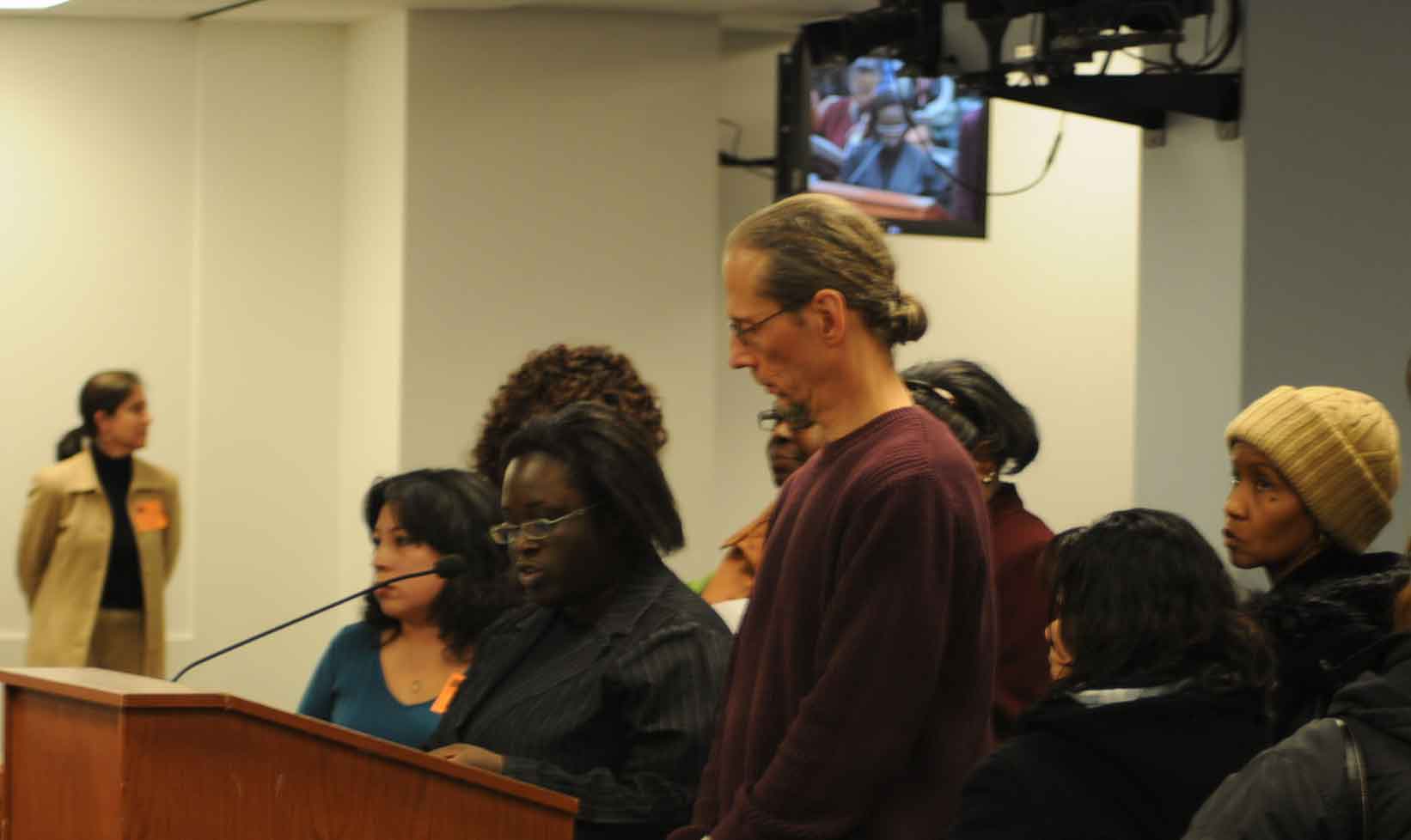 One of the many teachers who challenged CPS claims that it was providing improved education for students when schools were closed was Nikita Bryant (above, at microphone) who is a member of Teachers for Social Justice. Bryant described how despite the awards and recognitions she has received for her teaching, CPS had closed schools and displaced her for working in the inner city. Substance photo by George N. Schmidt.State Representative Kenneth Dunkin and Robert Elchert, an aide to Alderman Pat Dowell (Third Ward) both spoke against the selective and magnet school policy changes that will no longer use race to determine admission, which they claim will lead to less diversity.
One of the many teachers who challenged CPS claims that it was providing improved education for students when schools were closed was Nikita Bryant (above, at microphone) who is a member of Teachers for Social Justice. Bryant described how despite the awards and recognitions she has received for her teaching, CPS had closed schools and displaced her for working in the inner city. Substance photo by George N. Schmidt.State Representative Kenneth Dunkin and Robert Elchert, an aide to Alderman Pat Dowell (Third Ward) both spoke against the selective and magnet school policy changes that will no longer use race to determine admission, which they claim will lead to less diversity.
The final assault on the Board began when almost 80 angry African American people entered the Board chambers chanting “Educate or Die!”
Phillip Jackson, the head of the Black Star Project and former Chicago Housing Authority chief (and once Chief of Staff to Paul Vallas, Mayor Daley's first "CEO" at the Chicago Public Schools), said the civil rights of black children are on trial here today and if the Board passes the new policy for admissions to selective enrollment schools that will no longer consider race (it did), then “you’ll be on the wrong side of history.”
Jackson noted that race is still being used throughout the country to ensure diversity in school admissions while another speaker noted that even though only 8 percent of public school students are white, they make up 40% of the selective enrollment schools.
Jackson echoed the notion that low test scores mean that schools are "bad."
“You want our kids to go to the worst schools? You are not giving kids a choice, you are giving them a sentence,” Jackson said to applause all around. Many speakers who followed Jackson noted the Board’s decision will “re-segregate the selective schools.” Despite his extensive knowledge of the city and school system, Jackson at no point noted that the majority of the schools in Chicago remain complete segregated, and all-minority. All of the discussion since November (when Huberman unveiled the new plan) involves the fewer than 100 magnet, gifted, and selective enrollment schools that were created to be not-segregated during the years of the Desegregation Consent Decree.
Fourteen speakers were called and spoke after Jackson. Suddenly, the Board ended public participation with eighteen speakers still waiting to speak, including a group that were actually standing in line when Clare Munana announced that the public participation was over. The latest exclusion of people from public participation has been going on, as the Chicago Board of Education meets under tighter and tighter security, in the face of growing opposition from across Chicago, for several years. [See for example the report in Substance from March 2008 on how CPS kept hundreds of protesters outside the building while it voted on the school closings at its February 2008 meeting, http://www.substancenews. net/articles.php?page= 133§ion= Article and other back issues of Substance now on line].
When the public portion of the Board meeting ended and the smoke started to fade, Huberman then made two slick Power Point presentations on why the Board must pass the new one-year policy on magnet selective enrollment admissions and modifications to the school closing guidelines. Both are supposed to be posted on the Board's Web sites, but were not as of Substance press time (Friday, December 18, 6:00 a.m.) for this article.
Huberman said the new admissions policy which will ensure more socio-economic diversity was mandated by the recent court ruling that struck down the desegregation consent decree in Chicago. It is for only one year, after which they can revisit the policy that will take a look at several categories including the parent’s income level, English spoken as a second language, and single parent status, he said.
Board of Education attorney Patrick Rocks said those schools that still use race as a factor for admission do so because they were able to prove there is a “compelling government interest” on an individual basis.
Huberman’s next presentation focused on modifications to the school closing guidelines that will include a “Student Bill of Rights.”
Keeping one step ahead of his opponents, Huberman said, in answer to the critical University of Chicago consortium report that stated the Renaissance Plan has failed because most kids at closing schools didn’t do better in their new schools, now CPS will only assign students to schools that have performed better than their original school on the CPS performance policy, and those who transfer will get extended school time and a mentor to ensure a smooth transition. If there is no better school within a 1.5 mile radius of the home, then they will bus the student.
Also according to the new guidelines, a school can be recommended for closure if the school earned less than 33.3% of available points on the performance policy for two consecutive years. Huberman’s infamous “performance data” includes test scores, attendance data, trends and “other key indicators.”
A school can also be recommended for closing if its current or projected enrollment falls below 250 students and it is utilizing less than 40% of the building’s design capacity.
Despite the fact that Mayor Daley and his schools chief intend to continue a hated policy that will continue to shuffle kids around schools when research shows mobility hurts children’s academic growth, privatization, union busting, and anti-affirmative action continue to roll on orders from City Hall and its corporate backers.


By: kugler
Only one answer — jail these public criminals
If these public employees refuse to listen to the public and continue to abuse students and staff with their illegal policies they need to be put in jail, nothing less. Huberman is a criminal who lies each time he speaks and should be the first to be sent to prison for his crimes against the children of Chicago.
Good story, jim.